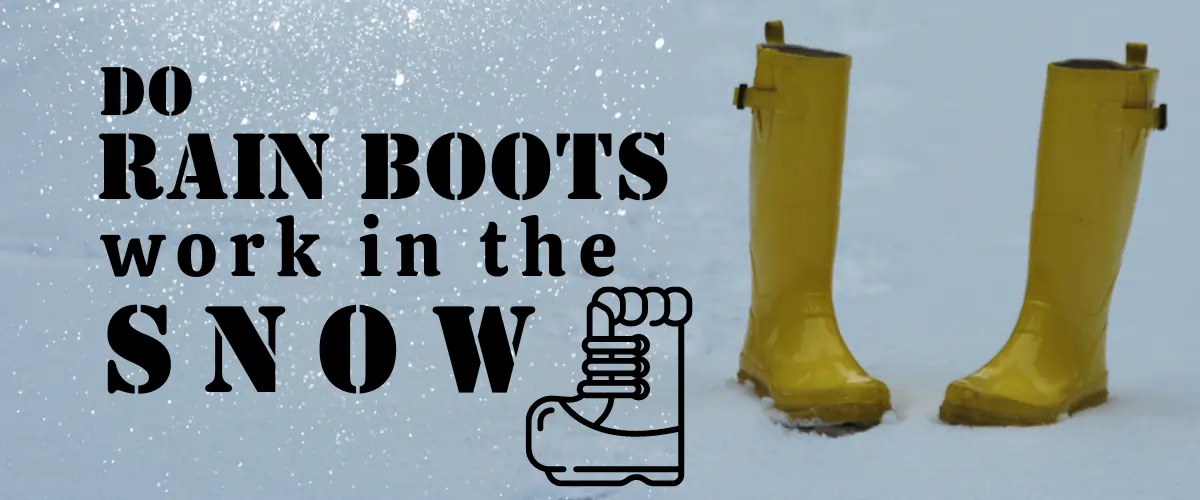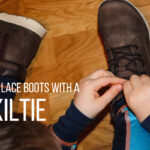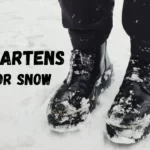Last Updated on November 27, 2023
Do rain boots work in the snow? At a glance, rain boots might seem apt for a snow-filled day. They ward off moisture in a deluge, so surely they’d be up to the task amidst snowflakes? Yet, while they may guard against the dampness of snow, they aren’t champions at cocooning your feet in warmth like their snow boot counterparts.
If you’ve invested in a sturdy pair of rain boots, you might question the necessity of adding snow boots to your collection. Snow, after all, is merely crystallized water, and your rain boots have ‘waterproof’ as their middle name. It could feel as though snow boots are a superfluous luxury.
But, as with many aspects of life, there’s depth beyond the initial perception. There are scenarios where rain boots might suffice on a snowy day, but there are also instances where nothing but true snow boots will do.
So, if you’ve got rain boots snugly fitting your feet, is it time to open your wallet for snow boots? What sets them apart? Dive in as we sift through these queries, guiding you to make a cozy and dry choice for the winter season.
Understanding the Fundamentals: Snow Boots vs Rain Boots
Navigating wet and cold terrains demands specialized footwear. Let’s delve deeper into the specifics of rain boots and snow boots, and how they rise to their respective challenges.
Rain Boots
These are the go-to for damp days, safeguarding our feet against puddles and downpours.
The Design and Purpose of Rain Boots
- Material Composition: Most rain boots are constructed from rubber or other synthetic materials. Their standout feature is undeniably their impermeability. While they are adept at keeping water out, they usually don’t have the insulation needed to ward off winter’s chill.
- Sole Design and Traction: The typical rain boot features a flat sole with sparse treads. This is sufficient for navigating wet streets or soggy gardens, but on icy terrains, they might not offer the grip required, increasing the risk of slipping.
- Traction and Safety: While rain boots are crafted with keeping water out in mind, their traction is often not designed for varied terrains, especially icy or slippery ones.
- Grip: Rain boots provide adequate grip on wet surfaces but can be treacherous on icy or snowy terrains due to their flat soles.
- Height: Most rain boots are mid-calf to knee-high, designed to prevent splashes from wetting the feet and lower legs.
- Weight: Generally, rain boots are lightweight, allowing for easy mobility during wet conditions without feeling cumbersome.
Snow Boots
Built for the rigors of winter, snow boots are designed to tackle both the cold and the challenging surfaces that come with snow and ice.
- Material Composition: Snow boots are usually made from a combination of leather, synthetics, and sometimes rubber. This blend ensures durability while providing much-needed insulation.
- Insulation and Warmth: The defining feature of snow boots is their insulation. They often contain layers of materials like fleece, thinsulate, or other specialized insulating materials, ensuring feet remain warm even in the harshest conditions.
- Traction and Safety: Snow boots are designed with the challenges of winter in mind. Their soles come with deep treads and are often made of materials that provide extra grip on snowy and icy surfaces.
- Water Resistance vs Waterproofing: While many snow boots are water-resistant, they might not always be entirely waterproof. However, their insulation ensures that even if some moisture enters, the feet stay warm.
- Height: Snow boots vary in height, from ankle-length to well above the calf, ensuring that snow doesn’t enter the boot.
- Weight: Snow boots tend to be heavier than rain boots due to their insulation and robust construction, but this added weight is a trade-off for the protection and warmth they offer.
Rain Boots in Snow: Is It a Good Idea?
Stepping out into a snowy day with rain boots might seem like a game of wardrobe roulette. Sure, rain boots are a staple for those torrential downpours, but can they really double up when the world outside looks like a winter wonderland?
The Light Snow Scenario
Living in a place where winter is more a light dusting of snow rather than a “Winter is Coming” episode? Your rain boots might just pass the test. They’ve been built to ward off water, so a gentle snowfall shouldn’t pose much of an issue. The PVC or rubber composition of most rain boots will ensure that any melting snow doesn’t seep in. For those quick jaunts, like hopping out to grab the mail or making that short walk to your car, rain boots could be your ally.
Now, let’s talk fashion. Rain boots have evolved from being mere functional items to fashion statements. Their sleeker and often more minimalistic design can seamlessly fit into a chic winter outfit. So, if your agenda involves strutting your stuff with style without spending prolonged hours in the cold, rain boots could take the crown.
The Intense Winter Quandary
But what if your hometown mirrors the frozen tundras of the Arctic? Relying solely on rain boots might just be a chilly mistake. Their primary flaw? Insulation, or the lack thereof. In sub-zero temperatures, a rain boot’s thin layer won’t stand a chance against winter boots padded with insulating materials. Treading on this icy path could range from cold toes to the more severe risk of frostbite.
And if you’re the adventurous kind, planning on meandering through snowy landscapes or even just long city walks, rain boots might let you down, literally. Their traction is typically not designed for slippery, icy terrains, which increases the risk of unexpected tumbles.
The Compromise: Woolen Armor
If you’re dead set on your rain boots for those colder climes or extended stints in the snow, here’s a tip: invest in a good pair of thick, woolen socks. Think of them as a makeshift insulation layer. While they won’t replicate the full insulation of a dedicated winter boot, they can offer some respite from the biting cold.
ShoesPundit Advice
Rain boots, in the realm of light snow and short excursions, might prove sufficient. But when winter decides to unleash its full fury, it’s wise to be equipped with boots designed to take on the chill and the slippery surfaces. After all, the right gear not only ensures comfort but also safety. So, next time snowflakes start descending, give a thought to the journey ahead and choose your footwear wisely.
What are the Best Rain Boots to Wear in Snow?
The shift from drizzles to snowflakes doesn’t necessarily mean sidelining your favorite rain boots, but it does mean being more discerning in your selection. If you’re adamant about donning rain boots in snowy conditions, there are a few boxes that need checking to ensure both comfort and safety. Here’s what to look out for:
1. Embedded Insulation:
Rain boots with added insulation provide an edge in the cold. Look for boots lined with thermal materials like neoprene or fleece. This not only offers an extra layer of warmth but also enhances the overall comfort. Brands like Bogs and Muck Boot often feature models designed with a built-in insulating layer suitable for colder climes.
2. Pronounced Treads for Superior Traction:
Snow and ice present their own unique challenges, and slippage is a primary concern. To combat this, your rain boots should have deep, pronounced treads. The deeper the grooves, the better they will grip onto slippery surfaces, offering stability and confidence with every step. Some rain boots, aware of their traditional flat sole design, have started to incorporate more rugged outsoles specifically for this purpose.
3. High-Quality Materials Resistant to Cold-Induced Wear and Tear:
Not all materials are created equal, especially when subjected to cold temperatures. The ideal rain boot for snowy conditions should be made from high-grade rubber or synthetics that remain flexible and durable even in freezing conditions. Some materials can become brittle in cold weather, leading to cracks and compromised waterproofing. Seek out reputable brands known for their cold-resistant materials to ensure longevity and performance.
Traditional rain boots might not be the perfect fit for snowy terrains, with careful selection, you can find models tailored to bridge the gap between wet and icy conditions. Investing in quality and features suitable for winter will ensure your rain boots serve you effectively, come rain or snow.
Practical Experiences: Rain Boots in Snowy Conditions
While technical specifications and features of boots can offer insight, sometimes the most enlightening information comes from those who have trodden snowy terrains in their rain boots.
Feedback from Workers in Cold Regions:
Personal anecdotes shed light on the true efficacy of rain boots in the snow. Their tales give us a ground reality check.
Anna’s Shares Her Experience With ShoesPundit from Alaska:
Anna, a dedicated rancher, had always been at one with nature. One winter morning, thinking the snow was light enough, she chose her rain boots for her chores. “The morning frost was deceptive,” she said. “As the day progressed, my feet felt trapped, almost frozen. The wetness was kept at bay, but the cold was unrelenting. And the slippery paths? Let’s just say I had a few near-misses. Rain boots might be waterproof, but they’re no match for Alaskan winters.”
Mike’s Experience in Minnesota:
Another account comes from Mike, a construction supervisor from Minnesota. “Rain boots are alright for a dash to the truck. But on the site, surrounded by ice and snow for hours? They just don’t cut it. I learned that the hard way when I ended up with frost-nipped toes.”
Duration of Wear:
The amount of time you intend to be outdoors significantly influences the effectiveness of rain boots in snow.
Quick Errands:
For short jaunts to the mailbox, taking out the trash, or any task that requires minimal exposure to the cold, rain boots might be adequate. Their primary design to repel water can be beneficial in these scenarios.
Prolonged Exposure:
However, if your day entails extended hours outdoors – be it work, recreation, or otherwise – rain boots are not the most dependable choice. As the cold seeps in, the lack of insulation becomes glaringly evident. Additionally, the risk of slips and falls amplifies, given that rain boots aren’t typically designed for icy terrains.
Pros and Cons of Using Rain Boots in Snow
Every footwear has its specific design and intended use. The same goes for rain boots and snow boots. For those who have pondered wearing rain boots in the snow, let’s break down the advantages and drawbacks.
| Criteria | Pros of Using Rain Boots in Snow | Cons of Using Rain Boots in Snow |
|---|---|---|
| Waterproof Capability | Designed to be fully waterproof, ensuring dry feet. | May not handle deep snow or melted slush as effectively. |
| Versatility | Suitable for both rain and light snow. | Not effective for deeper snow or prolonged exposure to cold. |
| Cost | Typically less expensive than dedicated snow boots. | May require additional purchases like insulating socks. |
| Style and Design | Offered in various trendy designs and colors. | Typically not as insulated or as rugged as snow boots. |
| Insulation | Some higher-end versions offer light insulation. | Generally lack the heavy insulation of snow boots. |
| Traction | Sufficient for wet conditions like rain. | Often lack the deep treads needed for snowy and icy conditions. |
| Durability in Cold | Satisfactory for cool conditions. | In extreme cold, rubber can become stiff and might crack. |
| Breathability | Depends on brand and design. | Rubber or synthetics can cause sweating in prolonged wear. |
Smart Alternatives and Solutions
While rain boots may not be the first choice for snowy conditions, there are ways to boost their effectiveness for occasional snowy strolls.
Layering for Warmth
Rain boots aren’t typically lined with insulation, a vital feature for cold weather. But that doesn’t mean you can’t add some yourself.
- Woolen Socks: These are a game changer. Wool not only provides excellent insulation but is also efficient at wicking away moisture, keeping your feet warm and dry.
- Thermal Inserts: Consider slipping thermal insoles into your boots. They act as a barrier against the cold ground and enhance overall foot warmth.
Enhancing Grip with Snow Grips or Overboots
The flat soles of rain boots might not offer the best traction on snowy paths. Here’s how to circumvent that:
- Snow Grips: These are external attachments that latch onto the bottom of your boots, offering spikes or deep treads to combat slippery surfaces.
- Overboots: If you’re facing deep snow, consider overboots. These slip over your regular footwear, providing an extra layer of protection and grip.
Conclusion
Navigating the world of footwear for diverse weather conditions can be tricky. While rain boots can serve as a makeshift solution for snow, for true comfort, safety, and warmth, snow boots reign supreme. As with any gear, the right choice is pivotal, not only for comfort but safety. Remember, in the dance of snowflakes, let your feet move with confidence, not caution.
FAQs
1. Do rain boots offer adequate grip in snow?
The traction of rain boots on snowy surfaces largely depends on their sole design. Many rain boots come with smoother soles, making them susceptible to slips in the snow. However, some brands have begun incorporating more textured soles, providing better stability on snowy grounds.
2. Are boots with waterproofing suitable for snowy conditions?
While waterproofing is an essential attribute for snowy conditions, it’s only a part of the equation. Yes, waterproof boots prevent snowmelt from entering, but many rain boots lack the insulation needed to keep feet warm in snow. So, while they might keep you dry, they might not keep you warm.
3. Can Hunter rain boots be used in snow?
Hunter rain boots will serve you well for short jaunts in the snow, say, from your doorstep to your vehicle. They’ll shield your feet from getting wet. But remember, they lack the insulation required for prolonged exposure to cold, so extended use in snow could lead to chilly feet.
4. What’s the ideal attire to pair with rain boots during winter?
Pairing rain boots with thermal leggings or thick woolen socks can boost warmth. Additionally, long coats or puffer jackets with scarves can complement the look while ensuring you stay cozy in colder climates.
5. What is the proper way to wear rain boots?
Rain boots are versatile and can be worn in several ways. For optimal comfort, wear them with cotton or wool socks, especially during colder months. For a chic look, pair them with skinny jeans or leggings tucked in. On rainy days, a trench coat or a stylish waterproof jacket can complement the boots.
6. Are rain boots slippery in the snow?
Often, rain boots can be slippery on snowy or icy terrains due to their smoother sole designs. It’s essential to check the tread pattern before using them in snowy conditions. Some modern rain boots, however, come with improved traction suitable for light snow.
Mark Walter is an accomplished researcher and writer with a wealth of knowledge and experience in the world of work boots. His expertise in this field is unmatched, having worked in a variety of industries and work environments. Mark's writing is clear and concise, making him an ideal source of information for anyone looking to learn more about the importance of selecting the right work boots for the job.

















